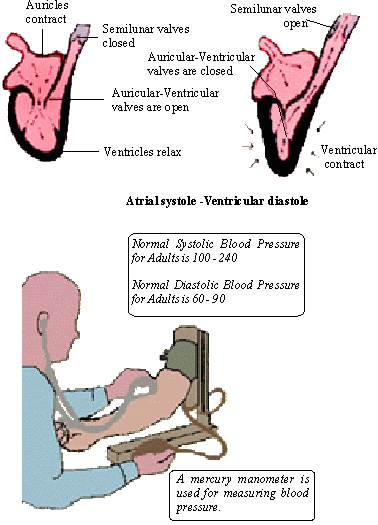|
PinkMonkey Online Study Guide-Biology
18.3 Arterial Blood Pressure
Blood pressure may be defined as the pressure exerted
by the blood against the vessel walls which contain it. This pressure
is greatest in the arteries during ventricular contraction (systole),
and is called systolic pressure. During ventricular relaxation
(diastole), blood pressure falls, reaching a minimum pressure just
prior to the next systole. The minimum pressure is referred to as
diastolic pressure.
Average arterial pressure during systole is about
120 mm Hg in an adult, while the diastolic pressure is about 80
mm Hg. This is normally expressed as blood pressure of 120/80, the
upper number indicating systolic pressure and the lower number indicating
the diastolic pressure. From these figures it is obvious that there
is a fluctuation in blood pressure during each heart beat. The difference
between these two pressures, 40 mm Hg, is termed pulse pressure.
Figure 18.8

Blood pressure is measured by an apparatus called
the sphygmomanometer, which measures blood pressure in an
artery. When the blood pressure is taken, the cuff is wrapped around
the arm just above the elbow over the brachial artery, and
air is pumped into the bag. A stethoscope is placed over the artery
so that the pulse can be read. Air is pumped untill flow stops in
that artery and the sounds cease. Now the bag is slowly deflated
until blood starts to flow and the pulse (sound) can just be heard.
The manometer reading at this time indicates systolic pressure.
Deflation of the bag is continued and a reading just before the
last pulse sound is taken. This indicates diastolic pressure
i.e. lowest arterial pressure caused by the ventricular diastole
Extreme deviations from the normal blood pressure
(120/80) are indications of a heart malfunction, unusual blood volume
in the system, arterial inelasticity (arteriosclerosis),
kidney disease, etc. A decrease in the blood pressure below the
normal level is referred to as hypotension or low blood pressure.
This may happen due to low blood volume or sometimes due to a defect
of the heart. A persistant increase in blood pressure above the
normal level (say 160/95), is referred to as hypertension or
high blood pressure. People with high blood pressure are susceptible
to stroke, heart diseases, kidney failure, headaches, etc.
|
SUMMARY
(1) Animals have either an open or close
circulatory system. (2) In mammals, the heart is four chambered
with two auricles and two ventricles. (3) Oxygenated blood
from the left ventricle is carried by the aorta to different
parts of the body. The deoxygenated blood is carried by the
pulmonary artery to the lungs. (4) Valves within the heart
prevent the back flow of blood. (5) During heart beat, normal
heart sounds can be heard as "lub-dub" sounds. (6)
Blood pressure is the force exerted by blood on the walls
of the vessels. Systolic pressure is the maximum force exerted
during ventricular contraction (systole); diastolic pressure
is the minimum force exerted by the blood as ventricles relax
(diastole). (7) The normal blood pressure is 120/80. A persistant
deviation from this level is referred to as hypo or hypertension.
|
[next page]
|
Table of Contents
18.0 -
Introduction
18.1 -
Closed Vascular System
18.2 -
Heart
18.3 -
Arterial Blood Pressure
18.4 -
Blood
Chapter
19
|